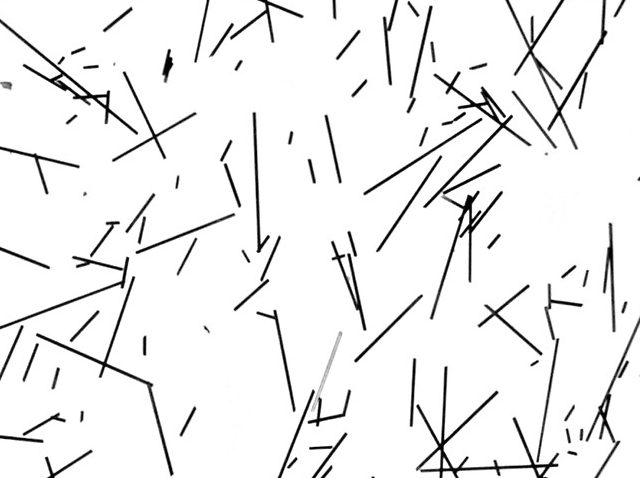The length and other geometrical properties of rCF are determinant parameters in the production of composite materials containing rCF. Depending of the recycling procedure the rCF staple fibers (fibers with finite length) are available as roving snippets (fiber collectives) or single fibers.
The geometrical characterization of rCF fibers, roving snippets, yarns and nonwovens is done with the measurement system FibreShape. The geometrical characterization of fibers provides the information to predict the quality, strength and uniformity of a fiber reinforced composite.
Examples
1. Length measurement of single fibers (provided by the Faserinstitut Bremen)


The histogram of the distribution density shows a distribution from 0,025 mm to 1mm. In total 1972 objects were analyzed. The average fiber length is 0,2 mm. The control of the area ratio, in this sample 9,62%, ensures that the fiber density is not too high.
2. Roving snippets of rCF (provided by STFI)
The sample of the analyzed roving snippets counts 118 objects. The roving snippets have a length of 4 mm to approximately 13 mm.


3. RCF-nylon-hybridyarns (provided by DITF)



The average width (mean value) of the wrappers measured with the parameter “minor axis of Legendre ellipse” is 0,56 mm (+/- 0,15 mm). The distribution density of the angles of the wrappers vary from approximately -25 to 55. The value 0 represents the x-axis. The distances between the wrappers vary from 0 mm to 3 mm. $
FibreShape – quality measurement
FibreShape provides the user with the safety of a standardized quality measurement (1). Knowing the properties of a raw material is the first step to create a high-quality product. FibreShape can be used for entrance control of the length and width of rCF but also to control the fiber length as part of the processing chain (2).
FibreShape relies on scanners. Read more about scanners here.
rCF length of staple fibers
The fiber length is a key characteristic important in the production of roving snippets, yarns and nonwovens. When working with short-fiber composites it has to be considered that for the transfer of stress there is relatively little interface per fiber. The so-called “critical length” of carbon fibers is approximately 5 mm. This length is necessary to ensure that the fiber can be stressed to its full strength (3).
Depending on the compound, different rCF lengths are realizable. (Hybrid-)yarns from rCF or thermoplastic foils work with a rCF length of about 15 mm to 80 mm. In the case of injection molding, short fibers below 6 mm are used. RCF that result from pyrolysis can either be used for injection molding if of short length or for nonwovens in case of bigger length.
Literature:
- ISO 9276 – 6, Representation of results of particle size analysis – Part 6: The descriptive and quantitative representation of particle shape and morphology, 2008.
- Fischer, H.; Schmid, H.G., Quality control for recycled carbon fibres; Kunststoffe International 103,11, p. 68 – 71. ISSN 0945-0084. (2013).
- Piggott, M.R., Interface Properties and their Influence on Fiber-Reinforced Polymers. Chapter 9 in Vigo, T.L. & Kinzig, B.J. (eds), Composite Applications – The Role of Matrix, Fiber, and Interface. Weinheim: Wiley-VCH, p. 221 – 265, (1992). ISBN 3-527-28094-4.

